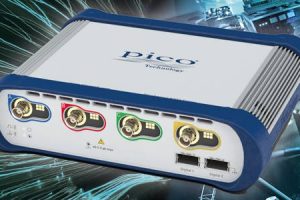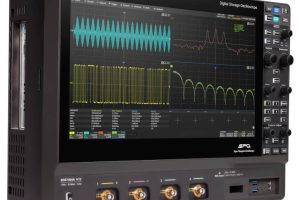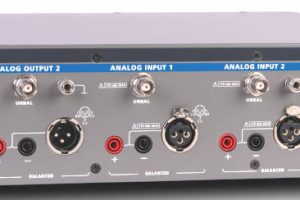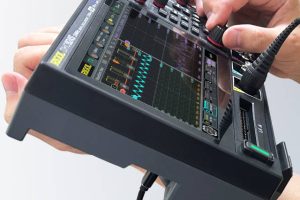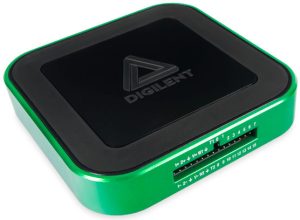
“Analog Discovery 2, AD3’s predecessor, has been used as a learning tool in hundreds of universities, and as a flexible benchtop tool by thousands of professional engineering companies and organisations across the globe” according to the company.
“We’re finding that its utility isn’t limited to traditional electrical engineers – we’ve heard positive reviews from civil, biomedical, mechanical and other disciplines as well,” added Digilent general manager Steve Johnson.
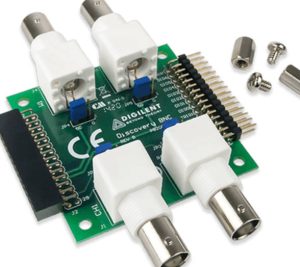 An optional BNC adapter (left) takes conventional two scope probes, and increases the oscilloscopes 9MHz bandwidth to over 30MHz. Two other BNCs are provided for the waveform generator’s outputs.
An optional BNC adapter (left) takes conventional two scope probes, and increases the oscilloscopes 9MHz bandwidth to over 30MHz. Two other BNCs are provided for the waveform generator’s outputs.
The rest of the instrument’s functions include: dual-output programmable power supply (needs external PSU), spectrum analyser, pattern generator, network analyser, voltmeter, curve tracer (needs optional add-on) and impedance analyser (via different optional add-on).
A PC running essential supporting software called WaveForms – available for Mac, Windows, or Linux – provides display and control.
This software also has a JavaScript editor which allows custom scripting of the instrument, and the WaveForms SDK (software development kit) can be used to create custom applications and scripts in Python, C, and additional languages.
The instrument is also compatible with LabVIEW (Digilent is part of National Instruments) and the Mathworks Matlab Data Acquisition Toolbox.
Scope inputs to the unit are two differential channels with dc coupling, which become two single-ended channels with ac or dc coupling if the BNC adaptor is added. FIR filters can be switched in to reduce high frequency noise.
There are two scope ranges: Low (≤500mV/div, 10Vp-p, ±5V offset range) and High (>0.5V/div 100Vp-p ±50V offset range), and resolution can be increased to 16bit with averaging. Max levels are ±50V or ±30Vrms.
There are 16 channels of 5V-tolerant 3.3V digital IO, individually programmable for the logic analyser, pattern generator or protocol generator, or simply as logic inputs or outputs.
Digital waveform interpretation includes SPI, I2C, UART, CAN, I2S, 1-Wire, PS/2, HDMI CEC, Manchester, JTAG and GPIB. Pattern generation includes: clock, pulse, random, number, binary counter, Gray counter, Johnson counter and decimal counter.
The two variable power outputs (0.5 to 5V and -0.5 to -5V) only reach there full 800mA/channel capability when a separate 5V PSU is plugged into the unit’s auxiliary barrel jack input.
There is a lot going on in this instrument, which is built around a Xilinx FPGA – some of the measurements, for example, are remarkably sophisticated. Take a look at its spec sheet for the full story – which is not on Digilent’s website yet (the unit is not on sale until 14 June). Meanwhile, click the ‘features’ tab on the Analog Discovery 3 web page to get an idea of its flexibility.
There is a short video om YouTube
 Electronics Weekly Electronics Design & Components Tech News
Electronics Weekly Electronics Design & Components Tech News
